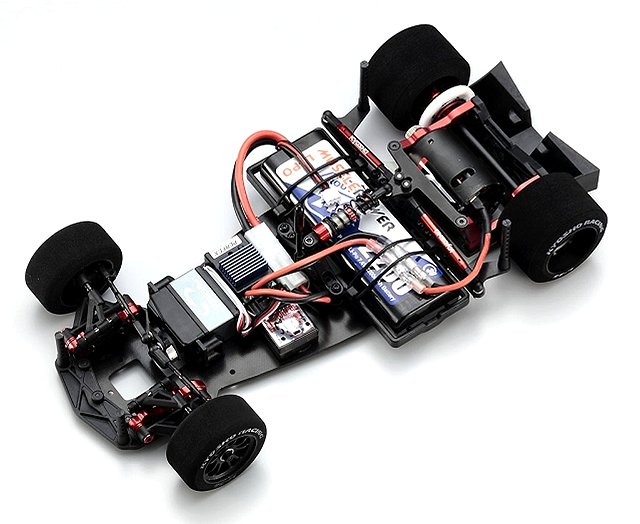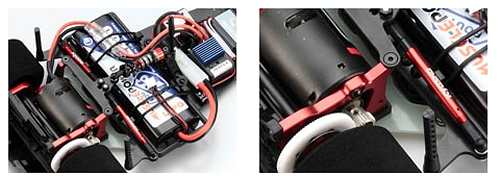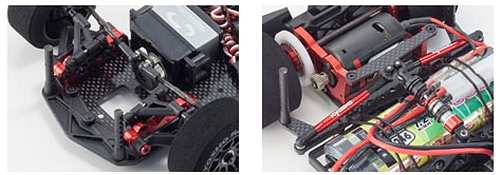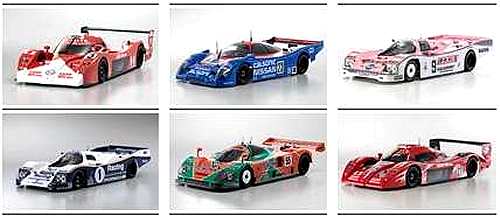

|
|
|


|
|
1/12 Scale Electric Pan Car:
Kyosho Plazma Lm
|
Released by Kyosho in 2013, the Plazma Lm pan car - # 30962 - is available with a number of bodyshell options, including, # 30924 - MAZDA 787B No.55 LM 1991, # 30923 - Toyota GT-One TS020, # 30922 - PORSCHE 962C Coupe and on the Plazma Lm Carbon Edition Chassis, # 30926C - PORSCHE 962C Joest Racing #9, # 30927C - TOYOTA GT-One TS020 1998 No.27 and # 30925C - NISSAN R90CP.
In 2015 Kyosho introduced the JAGUAR XJR-14 No.4/1991 LeMans 24h Version - # 30928C, on a Carbon Edition of the Plazma Lm.
The pan chassis comes with ball differential, coil spring over oil filled damper, a full set of ball bearings and is compatible with both 380 and 540 class motors.

To race the Kyosho Plazma Lm, it must be fine tuned to improve handling, provide responsive steering and give you the grip to cruise around corners at high speed, without slipping off the track. Small adjustments can make a Big difference and our step by step procedure, will guide you to the best Set-up for your individual driving style.








|
|
|

★ Kyosho Plazma Lm - Le Mans - Chassis ★

★ Kyosho Plazma Lm Carbon - Le Mans - Chassis ★

★ Kyosho Plazma Lm - Le Mans ★

|
Buying a Used Radio Controlled Model
|
|
Manufacturers and Brands Catalogued, Listed and Reviewed by RC-Scrapyard.
At present, the RC Model Manufacturers, Brands and Distributors covered by us are: ABC Hobby, Academy, Acme Racing, Agama Racing, Amewi, Ansmann Racing, ARRMA, Team Associated, Atomic RC, Axial, AYK, Bolink, BSD Racing, Capricorn, Carisma, Carson, Caster Racing, Cen, Corally, Custom Works, Durango, Duratrax, ECX - Electrix, Exceed RC, FG Modellsport, FS-Racing, FTX, Fujimi, Gmade, GS-Racing, Harm, HBX, Helion, Heng Long, Himoto Racing, Hirobo, Hitari, Hobao, Hong-Nor, Hot Bodies, HPI, HSP, Intech, Integy, Jamara, JQ Products, Kawada, Kyosho, Losi, LRP, Maisto, Mardave, Marui, Maverick, MCD Racing, Megatech, Mugen, New Bright, Nichimo, Nikko, Nkok, Ofna, Pro-Pulse, Protech, PTI, RC4WD, Redcat Racing, RJ-Speed, Robitronic, Schumacher, Seben, Serpent, Smartech, Sportwerks, Step-Up, Tamiya, Team-C Racing, Team Magic, Thunder Tiger, Tomy, Top Racing, Traxxas, Trinity, Tyco, Vaterra RC, Venom, VRX Racing, WLToys, X-Factory, Xmods, Xpress, Xray, XTM, Yankee RC, Yokomo, ZD Racing and Zipzaps. |
|
Hints, Tips and Information
Damper Pistons
When you first build your RC model, you will sometimes find that there are a number of different pistons in the kit, with varying numbers of holes or hole sizes in them. Generally, the manufacturer will suggest one particular piston in the car manual, and may provide you with a mid range oil weight, but depending on the type of terrain you intend to race your model, their suggestion may not be the best for your needs. |
|
Hints, Tips and Information
How to Reduce the Weight of your RC Model Car
If you ever step up and enter a regional, national or international event in RC, you will find one specific rule concerning the weight of your car.
|
|
RC Models:
|
Radio & Motors: |
Other
Accessories: |